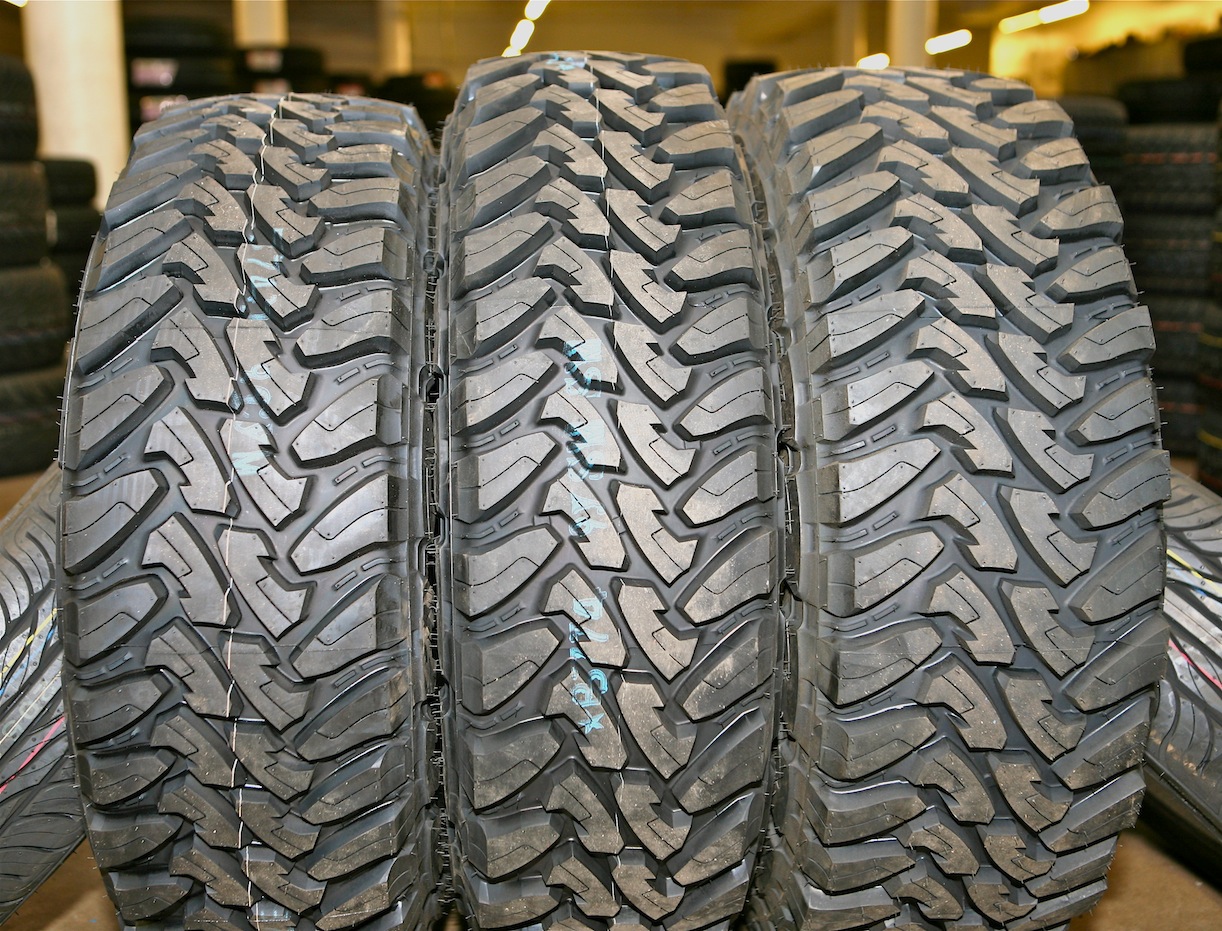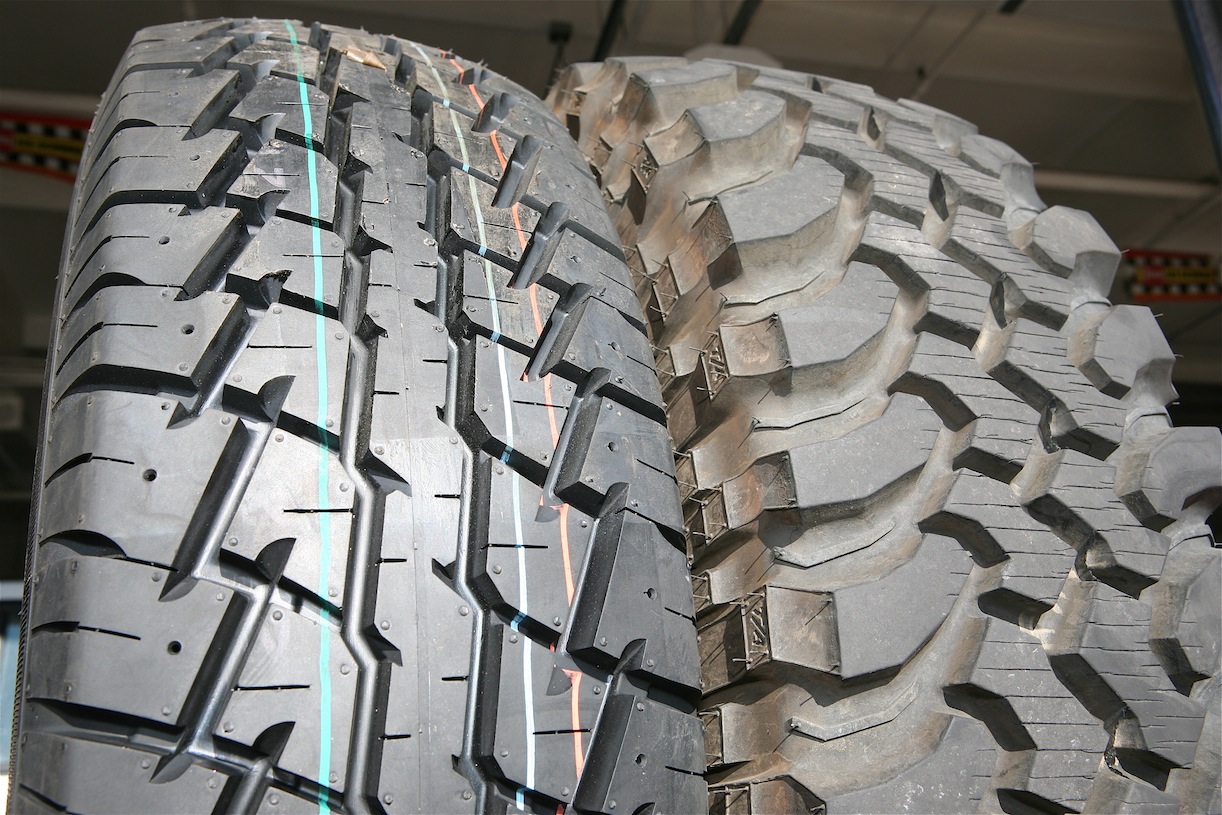Recently I received an email from Cliff with a few tire questions for the RoadTraveler (RT) blog. Below are his questions and my answers and comments, it’s a long one…Tires, they’re what’s on the menu today 😉
Background provided by Cliff: I have a few questions I hope you wouldn’t mind answering. First some background; I daily drive a 2010 Tacoma TRD Off Road with a FlipPac camper and OME suspension. Living in the Eastern Sierra I spend a lot of time on 395 between Reno and Los Angeles but, also drive many miles of desert washboard roads including the Death Valley area. I currently have stock tires, which are due for replacement. I have decided to invest in two sets of wheels, highway and off road.
RT. Two sets of wheels (or more) are very nice, and can save thousands of miles of needless pavement wear on your off-highway tires. However, there have been times when I didn’t have the correct wheels/tires on my truck when I ventured off-pavement because either the trip wasn’t planned or I made the wrong choice. Still, I like having a set of both more and less aggressive tires to choose from, but my all-around Dick Cepek F-C II get most of the miles.
One thing to be aware of is that two different treads might need different alignment settings to track straight and true on the same vehicle…I have lots of experience with this in recent years on my Toyotas and this is a solid argument against running two sets of wheels/tires.

Q. The highway set will likely be Michelin LTX M/S2 in a P-rated stock size. The off road tires I have yet to decide but, the short list includes, BFG KM2’s, Goodyear DuraTrac’s, or one of the Cooper off road tires. I have 7” wide wheels and would like to get into a taller narrower tire than stock.
RT. Are the stock tires on your Tacoma 265/70R16? You might consider running 265/75R16 for your replacements, though I don’t know if those Michelins are available P-rated? I assume your truck is relatively light with the FlipPac and doesn’t need more than the original P-rated tires. Though I’m not a big fan of what I consider the excessively stiff and/or short tire sidewall world we now live in (see Wheels, Tires, and Sidewalls) with your truck and intended use I would probably lean toward a load-range (LR) C tire if I could find the tread I wanted. If not, P-rated will work just as they have been.
Another question when discussing tire load ranges and ruggedness is have your OE tires been found severely lacking during the off-pavement travel you’ve already done? And even if the answer is yes, is a jump all the way to a load range E warranted, or would something more moderate like a load range C or D be more appropriate?
Reports on the Goodyear DuraTrac wear vary from excellent to very poor, and it seems the weight and/or driver of the truck has much to do with their longevity. Few complain about a lack of traction with the DuraTrac and a major positive is that Goodyear offers the LT265/75R16 size in both LR C and E, and I would suggested the LR C since you are concerned about of the ride quality penalties of an E-rated tire.
Q. My question is this. On rough washboard roads does the difference in tire volume between the following sizes 255/85-16, 235/85-16, and 265/75-16 make any noticeable difference in ride quality? Will one size tire provide a smoother ride over the others?
RT. The short answer is yes. Everyone’s butt dyno is calibrated differently, and truck loading, suspension, and tire PSI all make a difference. As I mentioned in the post linked above, I could clearly feel the difference between two sets of Toyo M/T ties on my 2005 Jeep Rubicon, both using the stock 16×8″ wheels, one 265/75R16E the other 285/75R16E. Both tires have 3-ply sidewalls and 7-ply treads. The only difference was the sidewall height and volume of air in the tires. I was aware of the slight but noticeable ride difference on relatively smooth local streets, and these differences were magnified once the impacts were deeper or sharper off-highway, even when aired-down.
So if you are merely analyzing the ride difference in sidewall height and/or volume, again the short answer is yes, one will provide a smoother ride than the other. But it is more complicated than that once you start changing load-ranges. All of the LT235/85R16 tires currently offered are E load range. My old favorite LT255/85R16 used to always be LR D, but now many have changed to load-range E. The LT265/75R16 size offers the most choice, with many load-range E treads, but a few LR D and C as well, just depends on the specific tire and manufacturer.
With the above in mind, it’s very difficult to say what size will offer a smoother ride based solely on the size or volume of air in the tire. Generally speaking, when running the same PSI, a LR D 255/85 will ride softer than a 235/85 or 265/75 LR E, a LR D 265/75 would ride better than a LR E 255/85, and a LR C 265/75 will beat them all. It should be noted that a LR C, 6-ply rated tire was considered a fairly heavy-duty light-truck tire a decade or two ago, and they can still be plenty depending on the rig, loading, and use. But those were the days before our super-sized world, which now includes; diesel pickups that have more torque and horsepower than commercial medium-duty trucks did, half-ton trucks with a payloads up to one ton, and 1-ton pickups that are rated for two tons or more in the single rear wheel (SRW) applications. Still, when one confirms the loads that modern light-truck (LT) tires are rated to carry, there is plenty of room to choose something less than a LR E for many applications.

Q. Most if not all narrow off road tires seem to be load range “E”. Is an “E” tire too stiff for a lightweight truck like the Tacoma?
RT. That’s your call, many people think they are fine. Load Range E tires have become the norm these days, though they are not needed or necessarily desirable for every light-truck or Tacoma, and while some think they are overkill and sometimes too stiff, they are certainly popular. The stiffer the truck’s suspension the more bothersome I find stiff tires. For example, I really prefer a load range D tire on my old F350 as without a ton or more on the rear springs the ride can be very firm on-road and jarring off-highway, but the added give in a tall LR D tire when aired down makes it much more pleasant. Of course if my truck was used at its maximum gross vehicle weight rating (GVWR) most of the time, a stiffer tire would be better. But I’ve found a LR D works well both empty and loaded with appropriate air pressure, the duty-cycle matters.
Compared to your stock P-rated tires I have little doubt you will be able to feel the difference—on and off-highway—if you slap on a set of LR E treads and run the same PSI. I would suggest a LR C or D, if they’re available in the tread you want.
Q. Would a “C” load range tire provide a smoother off road ride?
RT. Yes.

Q. I’m looking for a tuff, 3-ply sidewall, off road tire that will still provide a smooth ride in the rough stuff.
RT. Well that’s a tall order. The tougher the tire the rougher it will ride. The Toyo M/T I mentioned above is a very rugged tire, also a very stiff tire, particularly on a light truck. They are also expensive and typically balance very well. The new Cooper S/T MAXX is similar, very rugged but also stiff and firm riding…there is no free lunch. Remember that most LT tires still do not have 3-ply sidewalls, they have 2-ply sidewalls. Take two tires of essentially the same construction, one with the 3-ply sidewall and the other a 2-ply, the 3-ply sidewall tire will ride firmer. Preferring a more compliant ride, but sometimes needing a stout tire for heavy-hauling or puncture resistance in the rocks, I prefer a LR D with a 3-ply sidewall when I can get them, like the Dick Cepek Mud Countrys currently on my 4Runner, but that’s an uncommon configuration. Typically I just live with a regular 2-ply sidewall tire, like my current favorite, the Dick Cepek F-C II in a load-range D 285, which are currently on both my F350 and Tundra.
You should probably try to decide on the size and/or tread pattern you want first, then make the necessary concessions on load range and ply ratings, or visa-versa. You are not going to be able to have the most rugged tire, that is also very compliant on the washboard, just like the more aggressive treads generally don’t offer the wear of milder tread.
There are some other things to consider if you go taller than the 265/75R16 or 235/85R16 sizes (31.7–32″) on your Tacoma: Will your spare tire still fit in the OE location, is that important to you, and is the loss of torque and possibly fuel economy worth the switch to LT255/85R16 tires with stock gearing? Though I purchased a 4th Gen. 4Runner, I’ve often considered the 2005-up Tacoma platform, and thought that a 32-ish tall tire was very good compromise while begin able to run the correct, matching size spare without a tire swing-away.
Though in your case, the 255s would likely only be for occasionally use, and maybe the loss in acceleration and having a smaller spare would not be a deal-breaker? Since the Taco is a traditional, part-time 4WD system, there is not much concern when running a slightly smaller, 265/75 spare for short distances as long as the VSC and ATRAC don’t mind; they didn’t on my 4Runner when I ran that combination for a brief test.
Rollin’ Forward with RoadTraveler
Copyright © 2012 James Langan
